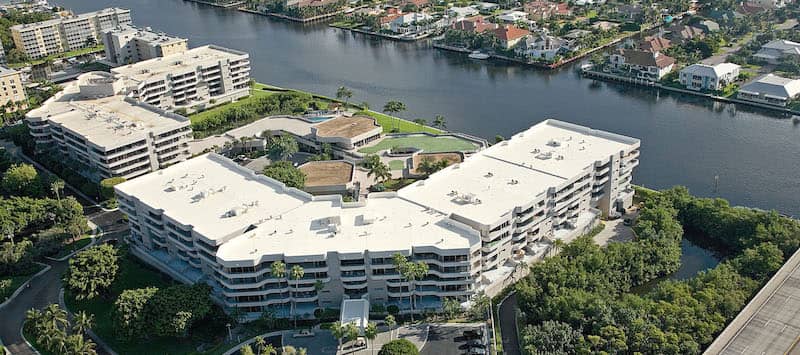I admit that I am a bit biased when it comes to mechanically fastened versus adhered roofing systems. When I started with Seaman Corporation 32 years ago, mechanically fastened assemblies were favored in the industry. In contrast, over the past 15 years, there has been an increase in specifying and installing adhered membrane roofing systems. This is not necessarily a negative. However, it is somewhat unexpected when you consider the history, understand the dynamics of the roof system’s actual performance and compare it to the way performance is tested.
There appears to be an increased confidence in the adhered roofing systems over mechanically fastened systems due to the elimination of flutter of the roof membrane. However, history has proven that roofing systems that utilize mechanical fasteners to engage the structure outperform adhered membrane systems in significant wind events. Building owners often fear their roof will be completely blown off during a significant wind event. Although it is rare this would happen in most parts of the country, catastrophic winds have been known to hit coastal areas of the United States. I learned this firsthand while surveying roofs with RICOWI (Roofing Industry Committee on Weather Issues) following Hurricane Katrina.
The most significant damage to the roofs and building interiors was observed where the adhered membranes were peeled back from the perimeters of the buildings. The lack of restraint to act as a barrier to peel was evident in the majority of the roofs we investigated. The investigation eventually led to a “peel stop” article, Enhancing Single Ply Wind Performance, by Single Ply Roofing Industry (SPRI).
The peel effect that accompanies perimeter displacement due to the force of a significant wind gust upon adhered systems can exasperate the damage that could have been mitigated if the adhered system had incorporated a mechanically fastened backup system into the design. Mechanically fastened systems permit a more conclusive engineering evaluation because the “fabric” is attached to the structural components of the building.
Causes of Roof Failure
There are numerous issues that can contribute to peeling of an adhered roof system:
-
Edge failure
-
Inadequate securement
-
Air infiltration beneath the membrane
-
Internal building pressurization
While all of these can be factors for a roof failure in a significant wind event, edge failure is the biggest contributor. The best insurance policy against this is the addition of intermittent rows of fasteners, in or through the roof membrane, parallel to the exterior edges and corners of the building.
Seaman Corporation has been installing FiberTite® roofing systems since 1979. For the first 15 years, they were all mechanically fastened. The majority of these early roofing systems are still in service throughout the coastal areas of Florida and the southeastern seaboard.
FiberTite Roofing Systems have an engineered design for mechanically attached installation. Therefore, FiberTite roof systems are basic in mechanically attached systems, which is its strength. FiberTite has extensive FM/UL listings for its FiberTite roof systems. Due to FiberTite’s history, more listings exist related to mechanical attachment vs. adhered.
When engineering a mechanically fastened roofing system, there is a lot less subjectivity. Fastener withdrawal and membrane pull-through test performance values provide building design engineers data they can depend on. Alternatively, knowing that “peel” is the principle failure mode in an adhered assembly, the roof is not engineered based upon the peel strength of the membrane to the substrate. Lab performance testing is conducted that may or may not truly represent an actual wind event.
Adhered Membranes
There are variables associated with adhered assemblies. Temperature, application rates and drying times are just a few factors that can impact the overall performance of an adhered roof assembly. The expertise and judgment of the roofing contractor are paramount in ensuring that the assembly will perform when needed.
Adhered membrane systems do have their place in the market. This is especially true for structural concrete decks where mechanical attachment becomes less desirable. The improvements in polyurethane foam adhesive technology for bonding the roof assembly components to concrete roof decks are also very effective; however, this does not address the possibility of membrane peel during a significant wind event. It is ineffective to have all the components below the membrane remain intact while the membrane itself peels from the cover board or insulation facer.
FiberTite KEE roof membrane systems introduced its adhered membrane system in 1994. Prior to this introduction, an effective adhesive was unavailable to bond a KEE membrane. This led to engineering mechanically fastened roof systems for every deck type available. The FiberTite Fleeceback membranes were introduced in 1995. This led the way to expand the FiberTite adhered roof systems portfolio with six additional adhesive options. Today, FiberTite is known around the world for providing operational security to the world’s most powerful brands with its innovative, high-performance coated fabric membrane.
The adhered assemblies are performing well. This does not change the fact that for high wind performance, the adhered assemblies are often augmented or enhanced by mechanically attaching the membrane in the perimeters with peel stops.
What is your experience with adhered assemblies during a significant wind event? Have you had any particular issues that you feel a peel stop could have prevented? Share your thoughts in the comments.
-1.png?width=500&height=271&name=FiberTite_Only%20(500px%20wide)-1.png)



-1.png)